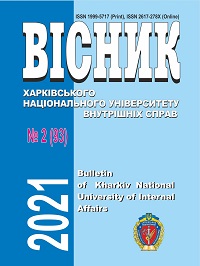Analysis of Additional Methods of purification of Mixtures while Conducting Differential Lysis under Sexual Crimes
Abstract
The article is focused on the problem of studying mixed biological traces during the research of the growing number and severity of sexual crimes. The presence of blood and epithelial cells with a small amount of sperm on things removed at the crime scene and smears from the victim’s body, complicates the molecular and genetic examination and the likelihood of obtaining a quality DNA profile from the sperm of the rapist. Therefore, the author has defined chemical basis of the standard method of differential lysis and the correlation of the components of the mixture of epithelial cells and sperm, which can help to get mixed and pure DNA profiles while amplify using the sets AmpFlSTR® Identifiler® PCR Amplification Kit, GlobalFiler STR PCR Amp Afication ™ PCR Amplification Kit. The author has analyzed literature data on the developed and perspective methods and additional stages of the differential lysis technique for purification of the mixture and aimed at sorting and reducing the number of epithelial cells. Chemical methods of mixture purification have been studied, including additional washing and incubation of the mortar, use of DNases, SDS lysis buffer and magnetic sorting with the use of antibodies (MOSPD3 and RH-20), and physical methods such as laser microdissection, acoustic lysis, hydrodynamic effect in small Reynolds numbers, microchips with additional integration of Cialyl Lewis oligosaccharide sequence and DEPArray technology. The main advantages and disadvantages of the procedures, the possibility of combining with other types, the impact on subsequent stages of molecular and genetic examination and the possibility of automating the research process have been provided for the methods. For the methods, the author has studied the probability of contamination during the procedure and the possibility of using for obsolete traces of sperm, where the destruction of sperm structure occurred. The author has indicated the possibility of automation of physical systems for forensic examination of molecular and genetic analysis by integrating the stages of sample preparation, cell counting and DNA isolation on a single device, which will reduce the time of the analysis of research objects in the future. The analysis of the literature data showed an improvement in the quality of DNA profiles while using the above methods, so it has been offered to use the presented methods for testing in expert practice.
Downloads
References
Puri P., Kumar N., Sharma D. and Shukla S., 2019. Differential organic DNA extraction of semen sample contaminated with blood for the identification of a serial sexual offender: A case report. Medico-Legal Journal, No. 87, pp. 32-35https://doi.org/10.1177/0025817218789569.
Zhao X.C., Wang L., Sun J. et al., 2016. Isolating Sperm from Cell Mixtures Using Magnetic Beads Coupled with an Anti-PH-20 Antibody for Forensic DNA Analysis. PLOS ONE, No. 11. https://doi.org/10.1371/journal.pone.0159401.
Diachenko N.M., Olkhovets S.O. and Lahus V.I., 2003. PCR DNA testing of biological objects [Doslidzhennia DNK z obiektiv biolohichnoho pokhodzhennia metodom polimeraznoi lantsiuhovoi reaktsii]. Kyiv: DNDEKTs MVS Ukrainy.
Wong H. and Mihalovich J., 2018. Automation of the Differential Digestion Process of Sexual Assault Evidence. Journal of Forensic Science, Vol. 64, Iss. 2, pp. 539-550. https://doi.org/10.1111/1556-4029.13877.
Timken M.D., Klein S.B. and Buoncristiani M.R., 2018. Improving the efficacy of the standard DNA differential extraction method for sexual assault evidence. Forensic Science International: Genetics, Vol. 34, pp. 170-177. https://doi.org/10.1016/j.fsigen.2018.02.014.
Lounsbury J. A., Nambiar S. M., Karlsson A. et al., 2018. Enhanced recovery of spermatozoa and comprehensive lysis of epithelial cells from sexual assault samples having a low cell counts or aged up to one year. Forensic Science International: Genetic, Vol. 864, Iss. 1, pp. 84-89. https://doi.org/10.1016/j.fsigen.2013.06.015.
Li X.-B., Wang Q.-S., Feng Y. et al., 2014. Magnetic bead-based separation of sperm from buccal epithelial cells using a monoclonal antibody against MOSPD3. International Journal of Legal Medicine, Vol. 128, pp. 905-911. https://doi.org/10.1007/s00414-014-0983-3.
Meredith M., Bright J.-A., Cockerton S. and Vintiner S., 2012. Development of a one-tube extraction and amplification method for DNA analysis of sperm and epithelial cells recovered from forensic samples by laser microdissection. Forensic Science International: Genetics, Vol. 6, Iss. 1, pp. 91-96. https://doi.org/10.1016/j.fsigen.2011.02.007.
Norris J.V., Evander M., Horsman-Hall K.M. et al., 2009. Acoustic Differential Extraction for Forensic Analysis of Sexual Assault Evidence. Analytical Chemistry, Vol. 81, Iss. 15, pp. 6089-6095. https://doi.org/10.1021/ac900439b.
Liu W., Chen W., Liu R. et al., 2015. Separation of sperm and epithelial cells based on the hydrodynamic effect for forensic analysis. Biomicrofluidic, Vol. 9, Iss. 4. https://doi.org/10.1063/1.4928453.
Horsman K M., Barker S.L.R., Ferrance J.P. et al., 2005. Separation of Sperm and Epithelial Cells in a Microfabricated Device: Potential Application to Forensic Analysis of Sexual Assault Evidence. Analytical Chemistry, Vol. 77, Iss. 3, pp. 742-749. https://doi.org/10.1021/ac0486239.
Inci F., Ozen M.O., Saylan Y. et al., 2018. A Novel On-Chip Method for Differential Extraction of Sperm in Forensic Cases. Advanced Science, Vol. 5, Iss. 9. https://doi.org/10.1002/advs.201800121.
Williamson V.R., Laris T.M., Romano R. and Marciano M.A., 2018. Enhanced DNA mixture deconvolution of sexual offense samples using the DEPArray™ system. Forensic Science International: Genetics, Vol. 34, рp. 265-276. https://doi.org/10.1016/j.fsigen.2018.03.001.
Copyright (c) 2021 Ya. O. Sinitsyna

This work is licensed under a Creative Commons Attribution 4.0 International License.




